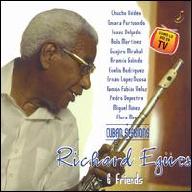Richard Egües
Biography
Flute player Richard Egües' three decades of work with Orquesta Aragón established him as one of the best (perhaps the best) practitioners of his instrument in the history of Cuban music. Aragón was a charanga -- an orchestra consisting mostly of strings and a rhythm section, with flute and violin as the lead voices; charangas originally played refined ballroom dances but later took a crucial role in creating the livelier cha cha. Egües arrived on the scene not long after improvisation had become a requirement for charanga musicians, and though he hadn't originally set out to become a flute player, his inventive performances with Aragón from 1954 all the way through 1984 set the highest possible standards of musicianship for flute players in the charanga format. Richard Egües was born in the town of Cruces, in the Cuban province of Las Villas; he was brought up alternately in the towns of Sancti-Espíritu (where he attended school) and Santa Clara (where his family resided). Egües' father landed a job leading the municipal orchestra of Manicaragua, and young Egües accompanied him there; his father allowed him his first performance experience playing cymbals. Egües began learning piano and clarinet, and soon branched out into saxophone as well. Around 1940, Egües' father founded his own orchestra, Monterey; Egües performed in it and also married around the same time. In 1943, he returned to Santa Clara hoping to prepare for a move to Havana by soaking up all the performance experience he could in the Santa Clara cabarets. Egües began playing both sax and piano with many different groups around Santa Clara. In the late '40s, he decided to pick up the flute as well, partly because flute players got to take more breaks during performances, and partly because the municipal orchestra of Santa Clara had an opening for a flute player. He got the job, and through that gig met Orquesta Aragón, who needed a flute player to occasionally fill in for their original flutist, Efrain Loyola. Egües initially turned down the orchestra's offer of a full-time position, which they then gave to Rolando Lozano; Egües, however, remained a dependable substitute, and when Lozano left the group in 1954, Egües accepted the job as his full-time replacement. With his extensive musical training, Egües became not only one of the band's chief instrumental stars, but a major talent in the fields of composition and arrangement as well. Along with violinist Rafael Lay Apezteguia -- the man essentially responsible for introducing the cha cha form (though he did not invent it) to the charanga orchestra -- Egües played a crucial role in giving the orchestra its signature voice: a light, airy, elegant sound, yet one that was driven by virtuosic, freewheeling improvisation. Despite their original base outside of the music hub of Havana, Orquesta Aragón became a world-renowned performing outfit, thanks in part to Egües' own personal popularity. Egües left Orquesta Aragón in November 1984, two years after Apezteguia was killed in a car accident. He founded his own orchestra, handling most of the composition duties, until he was forced to leave due to rather serious kidney problems. However, he was still able to record the album that became his first solo release in the United States in 1999; Richard Egües and Friends: Cuban Sessions was a guest-star-studded affair that captured Egües' flute playing in all its vitality. ~ Steve Huey, Rovi
Top Tracks
Albums
Videos
Close












